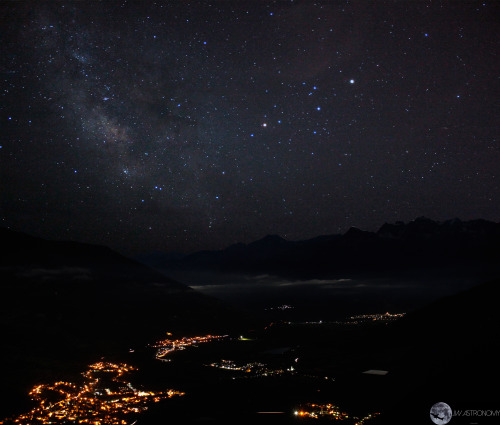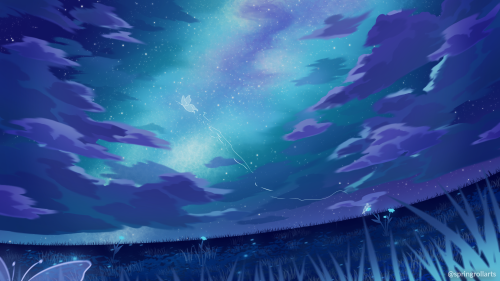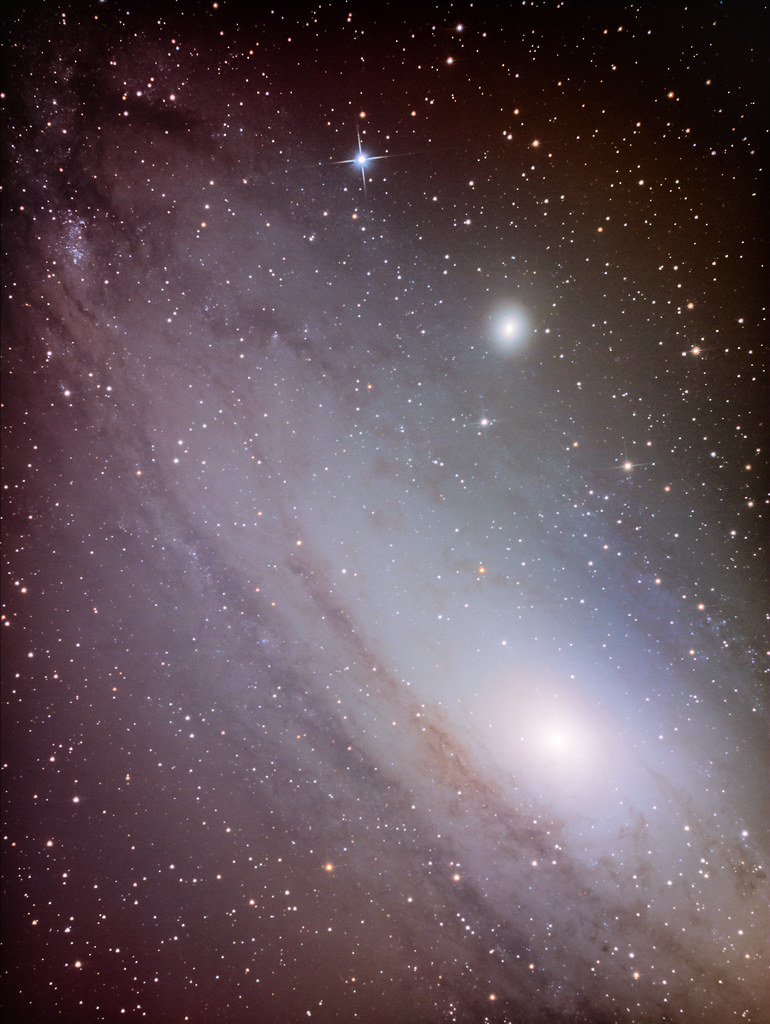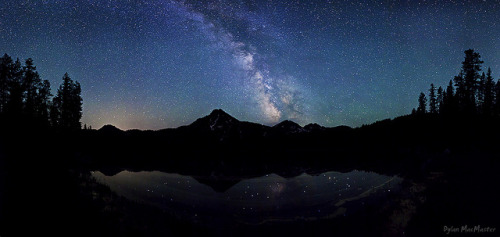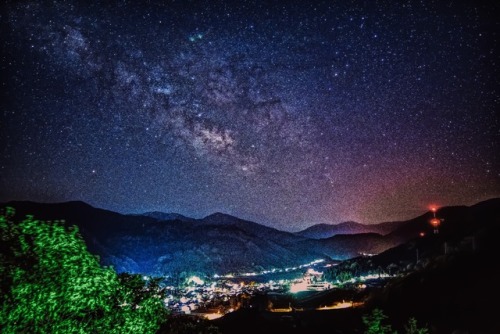#milky way

“Here Kiddie, Kiddie, Kiddie!”
Mars Milky Way

Happy new year! I hope everyone has a happy and healthy 2021 ✨
In this starry panorama streching across deep southern skies the South Celestial Pole is between the 2 bright galaxies and southern celestial gems. Across the top of the frame are the stars and nebulae along the plane of the Milky Way Galaxy. Gamma Crucis, a yellowish giant star heads the Southern Cross near the top center. Eta Carinae and the reddish glow of the Great Carina Nebula shine along the galactic plane near the right edge. At the bottom are the Large and Small Magellanic clouds, external galaxies in their own right and satellites of the mighty Milky Way.
Image Credit & Copyright: Petr Horalek, Josef Kujal

The open star cluster NGC 7380 is still embedded in its natal cloud of interstellar gas and dust commonly known as the Wizard Nebula. Seen on the left, it lies some 8,000 light-years away, toward the constellation Cepheus. Recorded with narrowband filters, the visible wavelength light from the nebula’s hydrogen, oxygen, and sulfur atoms is transformed into green, blue, and red colors in the final digital masterpiece. Image Credit & Copyright: Andrew Klinger

This galaxy, known as NGC 5907, seems to be an elongated line of stars and dark dust. But, the galaxy is actually categorized as a spiral galaxy just like our own Milky Way. In this new image from the NASA/ESA Hubble Space Telescope, we don’t see the beautiful spiral arms because we are viewing it edge-on, like looking at the rim of a plate. It is for this reason that NGC 5907 is also known as the Knife Edge galaxy. It is about 50 million light-years from Earth and can be found in the northern constellation of Draco. Although not visible in this image, ghostly streams of stars on big arching loops extend into space, circling around the galaxy. It is believed that those are remnants of a small dwarf galaxy that was torn apart by the Knife Edge galaxy and merged with it over 4 billion years ago.
Image credit: ESA/Hubble & NASA, R. de Jong; Acknowledgment: Judy Schmidt (Geckzilla)

The featured wide-angle mosaic was taken over the steppe golden fields in Portugal in 2020. From such a dark location, an immediately-evident breathtaking glow arched over the night sky: the central band of our Milky Way galaxy. But this sky had much more. Thin clouds crossed the sky like golden ribbons. The planet Mars appeared on the far left, while the planets Saturn and Jupiter were also simultaneously visible – but on the opposite side of the sky, here seen on the far right. Near the top of the image the bright star Vega can be found, while the distant and faint Andromeda Galaxy can be seen toward the left, just below Milky Way’s arch.
Image Credit & Copyright: Miguel Claro (TWAN, Dark Sky Alqueva)
Our Weird and Wonderful Galaxy of Black Holes
Black holes are hard to find. Like, really hard to find. They are objects with such strong gravity that light can’t escape them, so we have to rely on clues from their surroundings to find them.
When a star weighing more than 20 times the Sun runs out of fuel, it collapses into a black hole. Scientists estimate that there are tens of millions of these black holes dotted around the Milky Way, but so far we’ve only identified a few dozen. Most of those are found with a star, each circling around the other. Another name for this kind of pair is a binary system.That’s because under the right circumstances material from the star can interact with the black hole, revealing its presence.
The visualization above shows several of these binary systems found in our Milky Way and its neighboring galaxy. with their relative sizes and orbits to scale. The video even shows each system tilted the way we see it here from our vantage point on Earth. Of course, as our scientists gather more data about these black holes, our understanding of them may change.

If the star and black hole orbit close enough, the black hole can pull material off of its stellar companion! As the material swirls toward the black hole, it forms a flat ring called an accretion disk. The disk gets very hot and can flare, causing bright bursts of light.

V404 Cygni, depicted above, is a binary system where a star slightly smaller than the Sun orbits a black hole 10 times its mass in just 6.5 days. The black hole distorts the shape of the star and pulls material from its surface. In 2015, V404 Cygni came out of a 25-year slumber, erupting in X-rays that were initially detected by our Swift satellite. In fact, V404 Cygni erupts every couple of decades, perhaps driven by a build-up of material in the outer parts of the accretion disk that eventually rush in.

In other cases, the black hole’s companion is a giant star with a strong stellar wind. This is like our Sun’s solar wind, but even more powerful. As material rushes out from the companion star, some of it is captured by the black hole’s gravity, forming an accretion disk.

A famous example of a black hole powered by the wind of its companion is Cygnus X-1. In fact, it was the first object to be widely accepted as a black hole! Recent observations estimate that the black hole’s mass could be as much as 20 times that of our Sun. And its stellar companion is no slouch, either. It weighs in at about 40 times the Sun.

We know our galaxy is peppered with black holes of many sizes with an array of stellar partners, but we’ve only found a small fraction of them so far. Scientists will keep studying the skies to add to our black hole menagerie.
Curious to learn more about black holes? Follow NASA Universe on TwitterandFacebook to keep up with the latest from our scientists and telescopes.
Make sure to follow us on Tumblr for your regular dose of space: http://nasa.tumblr.com
Cosmic Alphabet Soup: Classifying Stars

If you’ve spent much time stargazing, you may have noticed that while most stars look white, some are reddish or bluish. Their colors are more than just pretty – they tell us how hot the stars are. Studying their light in greater detail can tell us even more about what they’re like, including whether they have planets. Two women, Williamina Fleming and Annie Jump Cannon, created the system for classifying stars that we use today, and we’re building on their work to map out the universe.

By splitting starlight into spectra – detailed color patterns that often feature lots of dark lines – using a prism, astronomers can figure out a star’s temperature, how long it will burn, how massive it is, and even how big its habitable zone is. Our Sun’s spectrum looks like this:

Astronomers use spectra to categorize stars. Starting at the hottest and most massive, the star classes are O, B, A, F, G (like our Sun), K, M. Sounds like cosmic alphabet soup! But the letters aren’t just random – they largely stem from the work of two famous female astronomers.

Williamina Fleming, who worked as one of the famous “human computers” at the Harvard College Observatory starting in 1879, came up with a way to classify stars into 17 different types (categorized alphabetically A-Q) based on how strong the dark lines in their spectra were. She eventually classified more than 10,000 stars and discovered hundreds of cosmic objects!

That was back before they knew what caused the dark lines in spectra. Soon astronomers discovered that they’re linked to a star’s temperature. Using this newfound knowledge, Annie Jump Cannon – one of Fleming’s protégés – rearranged and simplified stellar classification to include just seven categories (O, B, A, F, G, K, M), ordered from highest to lowest temperature. She also classified more than 350,000 stars!

Type O stars are both the hottest and most massive in the new classification system. These giants can be a thousand times bigger than the Sun! Their lifespans are also around 1,000 times shorter than our Sun’s. They burn through their fuel so fast that they only live for around 10 million years. That’s part of the reason they only make up a tiny fraction of all the stars in the galaxy – they don’t stick around for very long.

As we move down the list from O to M, stars become progressively smaller, cooler, redder, and more common. Their habitable zones also shrink because the stars aren’t putting out as much energy. The plus side is that the tiniest stars can live for a reallylong time – around 100 billion years – because they burn through their fuel so slowly.

Astronomers can also learn about exoplanets – worlds that orbit other stars – by studying starlight. When a planet crosses in front of its host star, different kinds of molecules in the planet’s atmosphere absorb certain wavelengths of light.
By spreading the star’s light into a spectrum, astronomers can see which wavelengths have been absorbed to determine the exoplanet atmosphere’s chemical makeup. Our James Webb Space Telescope will use this method to try to find and study atmospheres around Earth-sized exoplanets – something that has never been done before.

Our upcoming Nancy Grace Roman Space Telescope will study the spectra from entire galaxies to build a 3D map of the cosmos. As light travels through our expanding universe, it stretches and its spectral lines shift toward longer, redder wavelengths. The longer light travels before reaching us, the redder it becomes. Roman will be able to see so far back that we could glimpse some of the first stars and galaxies that ever formed.
Learn more about how Roman will study the cosmos in our other posts:
- Roman’s Family Portrait of Millions of Galaxies
- New Rose-Colored Glasses for Roman
- How Gravity Warps Light
Make sure to follow us on Tumblr for your regular dose of space!
Visual ‘Autocorrect’ for NASA Space Telescope
Telescopes located both on the ground and in space continue to dazzle us with incredible images of the universe. We owe these sharp vistas to a series of brilliant astronomers, including Andrea Ghez – an astrophysicist and professor at UCLA – and the “Mother of Hubble,” Nancy Grace Roman.
Did you know that stars don’t actually twinkle? They only look like they do because their light has to travel through our turbulent atmosphere to reach our eyes. As the atmosphere shifts and swirls around, the light from distant stars is slightly refracted, or bent, in different directions. Sometimes it’s directed right at us, but sometimes it’s directed a bit to the side.
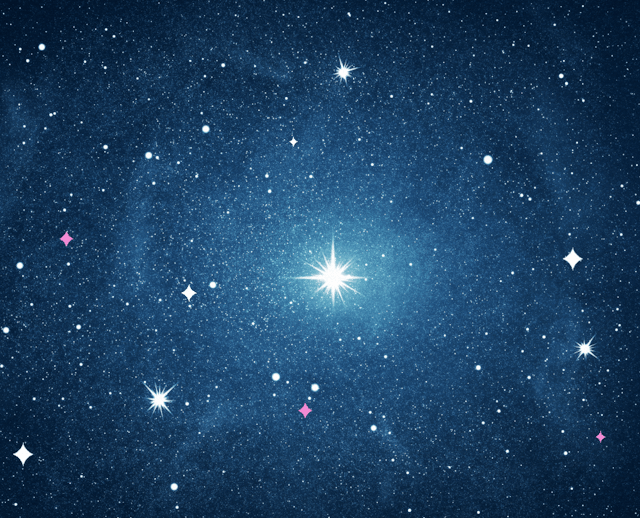
It’s like someone’s shining a flashlight toward you but moving it around slightly. Sometimes the beam is pointed right at you and appears very bright, and sometimes it’s pointed a bit to either side of you and it appears dimmer. The amount of light isn’t really changing, but it looks like it is.

This effect creates a problem for ground-based telescopes. Instead of seeing sharp images, astronomers get fuzzy pictures. Special tech known as adaptive optics helps resolve pictures of space so astronomers can see things more clearly. It’s even useful for telescopes that are in space, above Earth’s atmosphere, because tiny imperfections in their optics can blur images, too.

In 2020, Andrea Ghez was awarded a share of the Nobel Prize in Physics for devising an experiment that proved there’s a supermassive black hole embedded in the heart of our galaxy – something Hubble has shown is true of almost every galaxy in the universe! She used the W. M. Keck Observatory’s adaptive optics to track stars orbiting the unseen black hole.

A woman named Nancy Grace Roman, who was NASA’s first chief astronomer, paved the way for telescopes that study the universe from space. An upcoming observatory named in her honor, the Nancy Grace Roman Space Telescope, will use a special kind of adaptive optics in its Coronagraph Instrument, which is a technology demonstration designed to block the glare from host stars and reveal dimmer orbiting planets.
Roman’s Coronagraph Instrument will come equipped with deformable mirrors that will serve as a form of visual “autocorrect” by measuring and subtracting starlight in real time. The mirrors will bend and flex to help counteract effects like temperature changes, which can slightly alter the shape of the optics.

Other telescopes have taken pictures of enormous, young, bright planets orbiting far away from their host stars because they’re usually the easiest ones to see. Taking tech that’s worked well on ground-based telescopes to space will help Roman photograph dimmer, older, colder planets than any other observatory has been able to so far. The mission could even snap the first real photograph of a planet like Jupiter orbiting a Sun-like star!
Find out more about the Nancy Grace Roman Space Telescope on TwitterandFacebook, and learn about the person from which the mission draws its name.
Make sure to follow us on Tumblr for your regular dose of space!
Photographing Planets with the Roman Space Telescope
Nearly 100 years ago, astronomer Bernard Lyot invented the coronagraph – a device that made it possible to recreate a total solar eclipse by blocking the Sun’s light. That helped scientists study the Sun’s corona, which is the outermost part of our star’s atmosphere that’s usually hidden by bright light from its surface.

OurNancy Grace Roman Space Telescope, now under construction, will test out a much more advanced version of the same thing. Roman’s Coronagraph Instrument will use special masks to block the glare from host stars but allow the light from dimmer, orbiting planets to filter through. It will also have self-flexing mirrors that will measure and subtract starlight automatically.

This glare-blocking prowess is important because planets can be billions of times dimmer than their host stars! Roman’s high-tech shades will help us take pictures of planets we wouldn’t be able to photograph using any other current telescopes.

Other observatories mainly use this planet-hunting method, called direct imaging, from the ground to photograph huge, bright planets called “super-Jupiters” in infrared light. These worlds can be dozens of times more massive than Jupiter, and they’re so young that they glow brightly thanks to heat left over from their formation. That glow makes them detectable in infrared light.

Roman will take advanced planet-imaging tech to space to get even higher-quality pictures. And while it’s known for being an infrared telescope, Roman will actually photograph planets in visible light, like our eyes can see. That means it will be able to see smaller, older, colder worlds orbiting close to their host stars. Roman could even snap the first-ever image of a planet like Jupiter orbiting a star like our Sun.
Astronomers would ultimately like to take pictures of planets like Earth as part of the search for potentially habitable worlds. Roman’s direct imaging efforts will move us a giant leap in that direction!

And direct imaging is just one component of Roman’splanet-hunting plans. The mission will also use a light-bending method called microlensing to find other worlds, including rogue planets that wander the galaxy untethered to any stars. Scientists also expect Roman to discover 100,000 planets as they cross in front of their host stars!

Find out more about the Nancy Grace Roman Space Telescope on TwitterandFacebook, and about the person from which the mission draws its name.
Make sure to follow us on Tumblr for your regular dose of space!
One man and his headlamp: Photographer travels to remotest parts of Canada to capture the Milky Way in all its glory
Post link
Mountain Nights
Canon 60D
18mm
ISO 1600
F/3,5
25"Another shot from the Alps. Looking into the Vinschgau valley from the Watles Mountain. One of the most beautiful places i’ve seen!
Feel free to share!
Visit my new Website:
http://jwastronomy.com/
Post link




